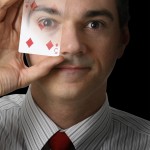 You can’t necessarily trust your brain.
You can’t necessarily trust your brain.
As magician/speaker Dan Trommater told IABC/Toronto’s Professional Independent Communicators at a meeting on Nov. 6, your brain sometimes fills in the blanks when you make assumptions. It also shuts off when you come up with the first answer to a problem, passing over what may be perfectly good ideas.
Dan dazzled the group with a trick that involved borrowing a $20 bill, folding it into a tiny package and making it disappear. He then cut open a lime to reveal — tada! — the same bill. After asking the audience for theories on how he did it, and just how strongly people believed their theories, he revealed that there were at least 10 possible methods.
Dan described telling this to an executive, who had been convinced he knew the only way the trick could be done. The man was stunned, and realized if he could be wrong about this, he could be wrong about many other areas where he was positive he knew the answer. And that was exactly Dan’s point.
“Are you making a decision based on theory-based evidence, or is it your brain filling in the gaps?” he asked the group, adding, “Throw away what you think you know.”
Dan also led an exercise to help us go beyond the first response to a problem. With a little prodding, we came up with dozens of practical, impractical and downright weird options.
“It’s human nature to ‘solve a problem’ and move on, but you leave a lot of good ideas behind,” Dan explained.
Some other points Dan gave us to ponder:
- Think of assumptions your clients make about you, and think about how you can be proactive in addressing them. For example, if what you do seems easy, you could educate the client on the process.
- What assumptions are you making about your clients?
- Although we try to do this all the time, you can’t judge what’s going on in someone’s head from outside their body.
- A simple, conversational, powerful tool to leave assumptions aside is to say, “Tell me more.”
As a reminder to shift our perspective and pay attention to the tricks our brains play on us, Dan handed out a card with an image of two tables. Although one appeared square and the other a rectangle, placing a red magnet over each in turn revealed both were identical. (See this illusion by Roger Shepard and other illusions by Al Seckel that show how we mis-think. “Optical illusions are as good as magic,” Dan says.)
He shared another reminder that what we think is “obvious” isn’t necessarily true, with the help of volunteer Janna Stam. From her perspective, she saw the wonder and magic of the cut rope trick. From the audience perspective, we could see some of the trickery.
“What is truth or magic for one person is clearly different for another,” Dan said. “It all depends on your perspective.”
Did you attend the meeting? What did you take away from the presentation? Please share in the comments below.

Great post Sue, and your summary of Don’s presentation was bang on. His session and magic clearly made us challenge our assumptions. Through his guidance, and the various exercises, we learned that a problem can have many solutions…it’s all about opening our minds and deconstructing our beliefs.
What was especially enlightening was the importance of taking this same approach and applying it to help support the needs of our clients and, by the same token, our own business.
Thanks for commenting, Lorraine!
Great write-up Sue! You captured all his essential points and gave me a real sense of how important it is to toss out our usual assumptions. Also liked the point about spending more time and not leaving good ideas on the table. Wish I’d been there. Good job!
Ellen
Glad you enjoyed it, Ellen! Thanks for taking the time to read and comment.